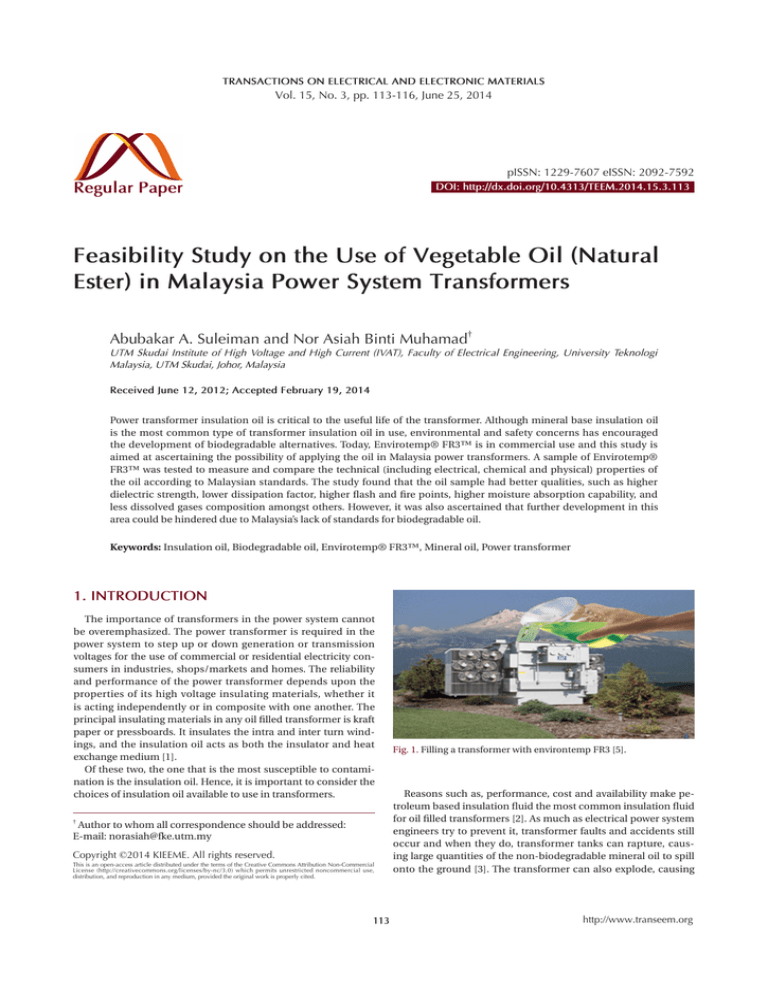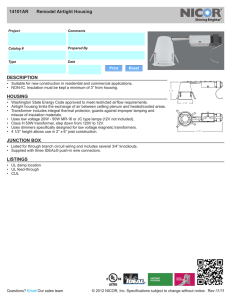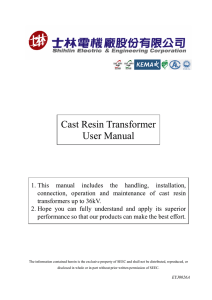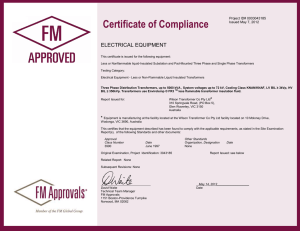
TRANSACTIONS ON ELECTRICAL AND ELECTRONIC MATERIALS
Vol. 15, No. 3, pp. 113-116, June 25, 2014
pISSN: 1229-7607 eISSN: 2092-7592
Regular Paper
DOI: http://dx.doi.org/10.4313/TEEM.2014.15.3.113
Feasibility Study on the Use of Vegetable Oil (Natural
Ester) in Malaysia Power System Transformers
Abubakar A. Suleiman and Nor Asiah Binti Muhamad†
UTM Skudai Institute of High Voltage and High Current (IVAT), Faculty of Electrical Engineering, University Teknologi
Malaysia, UTM Skudai, Johor, Malaysia
Received June 12, 2012; Accepted February 19, 2014
Power transformer insulation oil is critical to the useful life of the transformer. Although mineral base insulation oil
is the most common type of transformer insulation oil in use, environmental and safety concerns has encouraged
the development of biodegradable alternatives. Today, Envirotemp® FR3™ is in commercial use and this study is
aimed at ascertaining the possibility of applying the oil in Malaysia power transformers. A sample of Envirotemp®
FR3™ was tested to measure and compare the technical (including electrical, chemical and physical) properties of
the oil according to Malaysian standards. The study found that the oil sample had better qualities, such as higher
dielectric strength, lower dissipation factor, higher flash and fire points, higher moisture absorption capability, and
less dissolved gases composition amongst others. However, it was also ascertained that further development in this
area could be hindered due to Malaysia’s lack of standards for biodegradable oil.
Keywords: Insulation oil, Biodegradable oil, Envirotemp® FR3™, Mineral oil, Power transformer
1. INTRODUCTION
The importance of transformers in the power system cannot
be overemphasized. The power transformer is required in the
power system to step up or down generation or transmission
voltages for the use of commercial or residential electricity consumers in industries, shops/markets and homes. The reliability
and performance of the power transformer depends upon the
properties of its high voltage insulating materials, whether it
is acting independently or in composite with one another. The
principal insulating materials in any oil filled transformer is kraft
paper or pressboards. It insulates the intra and inter turn windings, and the insulation oil acts as both the insulator and heat
exchange medium [1].
Of these two, the one that is the most susceptible to contamination is the insulation oil. Hence, it is important to consider the
choices of insulation oil available to use in transformers.
†
Author to whom all correspondence should be addressed:
E-mail: norasiah@fke.utm.my
Copyright ©2014 KIEEME. All rights reserved.
This is an open-access article distributed under the terms of the Creative Commons Attribution Non-Commercial
License (http://creativecommons.org/licenses/by-nc/3.0) which permits unrestricted noncommercial use,
distribution, and reproduction in any medium, provided the original work is properly cited.
Copyright
2011 KIEEME. All rights reserved.
113
Fig. 1. Filling a transformer with environtemp FR3 [5].
Reasons such as, performance, cost and availability make petroleum based insulation fluid the most common insulation fluid
for oil filled transformers [2]. As much as electrical power system
engineers try to prevent it, transformer faults and accidents still
occur and when they do, transformer tanks can rapture, causing large quantities of the non-biodegradable mineral oil to spill
onto the ground [3]. The transformer can also explode, causing
http://www.transeem.org
Trans. Electr. Electron. Mater. 15(3) 113 (2014): et al.
114
the highly flammable oil to ignite and burn profusely. These two
reasons were primary in necessitating the extensive research to
find alternative insulation oil that is biodegradable with high
flash and fire points amongst other advantages. By the end of the
19th century, vegetable oil had been successfully developed for
commercial use and is currently used in many power transformers with remarkable performance. record [4].
Most of power transformers used in Malaysian power system
networks are filled with petroleum-based mineral oils as insulation fluid. These transformers contain large quantities of mineral
oil and can be disastrous to the environment in cases of tank
ruptures or leaks [6]. The objective of this study is therefore to
undertake a critical examination and ascertain the properties of
a natural ester vegetable oil sample (Envirotemp® FR3™), comparing it with the Malaysian Standard for oil filled transformers
as well as carry out a cost benefit analysis and environmental
impact assessment of using the oil in Malaysian power system
transformers.
Table 1. Electrical properties of sample vs FR3 and MS.
Type of test
Dielectric Break-
kV
down @ 2.5 mm
δ)
Power Factor (tan
%
Resistivity
GΩ.m
Type of test
Hydrogen
(H2)
Oxygen
(O2)
Nitrogen
(N2)
Methane
(CH4)
Carbon
Monoxide
Dissolved
Gas Analy-
(CO)
Carbon
sis
Dioxide
(CO2)
Ethylene
(C2H4)
Ethane
(C2H6)
Acetylene
(C2H2)
Total
Dissolved
3. RESULTS AND FINDINGS
3.1 Technical Analysis
The result of the Envirotemp® FR3™ natural ester oil sample tested was compared to the standard values given by MS
2322:2010 and the properties of ester given by the manufacturers
of the oil [7]. The Electrical, Chemical and Physical property results of the sample of oil tested are summarized in the tables 2 to
4 below
The result shows that the Envirotemp® FR3™ tested based on
the Malaysian Standard MS 2322:2010 has
i. Higher moisture content
ii. Higher dissipation factor
iii. Higher pour point
iv. Higher neutralization value
v. Lower Inter Facial Tension (IFT)
3.2 Cost benefit and performance assessment
Based on the information given on power transformers tripping that were recorded in the financial year (FY) 2008/09 and
2009/10 by TNB and the 2003 International Machinery Insurers’
Association (IMIA), and a worldwide study on the analysis of
transformer failures over a period of five years between 1997 to
2001 [8], it showed losses due to transformer insulation failures
in Malaysia. It compares power lost using mineral oil compared
to what it would have been if FR3 were used. The summary is
shown in Figs. 2 and 3 below
Furthermore, the use of the natural ester, biodegradable Envirotemp® FR3™ insulation oil can reduce this cost because the oil.
Test Result
Malaysia Std
FR3 Value
85
30 Min
≥40
0.005 Max
≤0.20
No limit at 90℃ ≥ 5e12 Ω-cm
0.01342
22
Table 2. Chemical properties of sample vs FR3 vs MS.
2. METHODOLOGY
A sample of the natural ester oil, from the manufacturer, was
tested according to the SIRIM certified standard MS 2322:2010
(Fluids for electroctechnical application - Unused mineral insulating oils for transformers and switchgear) [7]. This standard is
an adaptation of IEC 60296. The purpose of the test was to determine the electrical and physiochemical properties of the oil
sample and then compare the result to the MS Standard and the
manufacturers given property values.
The result of the test and analysis is presented in the next section.
unit
Malaysia
unit
Test Result
ppm
7
ppm
10410
ppm
54792
ppm
1
120
ppm
8
350
ppm
270
2,500
ppm
Nil
50
ppm
Nil
65
ppm
Nil
35
ppm
16
Comb Gas
Neutralization No.
mgKOH/g
(Acidity)
Moisture
ppm
Acidity
mgKOH/g
Oxidation
Sludge
%
Stability Power Fac%
tor (tan δ)
FR3 Value
Std
100
Not
specified
Not
Specified
0.02
0.01 Max
≤0.06
86
3.41
1.16
30 Max
1.2 Max
0.8 max
≤200
0
Table 3. Physical properties of sample vs FR3 vs MS.
Type of test
Color
Interfacial
tension (IFT)
Density
Flash point
Pour Point
Kinematic
Viscosity
Unit
No
Test result
L 1.0
Malaysia Std
1.0-2.5
FR3 Value
L 0.5
27
40 Min
25-28
g/cm
℃
℃
0.9195
240
-21.9
<0.895 Max
135 Min
-40 Max
≥340
≤-18
mm2/s
32.5
12 Max
≤40
mN/m
3
Pale yellow
Appearance
(No contamination)
Transparent,
Light green
i. Has a higher breakdown voltage; thus reducing risk of insulation breakdown at lower voltages.
ii. Has a higher flash point; thus less risk of failure due to fire [9].
iii. Has a higher viscosity and so has higher heat dissipation
rate; reduced operating temperature.
iv. Absorbs moisture expelled from kraft paper; therefore reducing its degradation rate and failure due to aging [10-12].
Trans. Electr. Electron. Mater. 15(3) 113 (2014): et al.
Fig. 2. Power (MVA) lost due to insulation related failure (FR3 vs. Mineral oil).
115
Fig. 4. Initial cost of insulation oils [18].
eral oil as shown in Fig. 4 below.
3.3 Environmental impact assessment
In this century, almost all engineering equipment designed
without the consideration of their impact to the sustainable development of the society (protection of the eco-system) or safety
of their operation can be deemed as failures. Therefore, environmental impact assessments of any new engineering design is essential for sustainable development. The impact of engineering
equipment is so important that existing equipment are being redesigned to fit our fragile ecology.
Therefore, in terms of the environment, natural ester insulation oil
Fig. 3. Estimate equipment losses due to insulation failure.
This study has established that natural ester/vegetable insulation oil
i. Has a higher dielectric breakdown voltage than mineral oil,
implying that it can withstand higher electrical stress under
the same operation and environmental conditions.
ii. H
as a higher susceptibility to absorb moisture from the kraft
paper, which is better than mineral oil. This characteristic
of ester oil is uniquely important as it reduces the rate of
kraft paper degradation and so elongates the life cycle of the
transformer [11-15].
iii. I s compatible with all components of the transformer because the long chain fatty acid structure of the oil makes it
non-corrosive; it has negligibly low chemical reaction with
the other transformer components [16].
iv. Has a high flash point, which invariably reduces the risk of
transformer fires due to insulation oil burning after arcing
faults inside the transformer.
v. Also has a high thermal withstand characteristic resulting
from the high flash point [17].
vi. Can be cost effective in terms of maintenance, operations
and performance.
vii. Is environmentally friendly and ease to dispose without
fear of toxicity to the eco system
So far, the major cost disadvantage for this oil is that it is not
readily available and so its initial cost is higher than that of min-
i. Is biodegradable and eco-friendly. It contains no toxic
chemicals.
ii. It has no waste disposal issues because it is perfectly eco
friendly.
iii. The source is renewable.
iv. No fire hazards when compared to mineral oils because of it
high flammable level.
4. CONCLUSIONS AND RECOMMENDATION
The Malaysian climatic and weather conditions are unique
with high humidity, frequent rain, and a lot of lighting [19]. So it
is pertinent that new insulation oil proposed to be used in the
power frequency transformers are tested before use. The test
should compare results with existing standards and show the
effect regarding the unique Malaysian weather on the biodegradable insulation oil Envirotemp® FR3™ when used in local
environmental conditions. At the end of this study, it was established that the feasibility study showed that the commercially
available biodegradable insulation oil could be introduced in
Malaysian power transformers either as new insulation oil or as
retro-fill.
4.1 Limitations
The cost benefit analysis is based on postulations that arrived
with reference to previous studies on transformer failures worldwide, as there was little data available from the public utility
company, TNB, despite the enthusiasm of that the VP TNB Transmission had in this research. The only information available
from TNB were the number of transformers in the power net-
116
work in Malaysia and unsigned causes of transformer tripping
recorded in the financial year (FY) 2008/09 and 2009/10.
4.2 Recommendations
With this conclusion reached, it is therefore recommended
that further work on this project should
i. Apply the oil in a transformer and monitor its performance;
retro filling will serve this purpose because the oil is compatible with the other transformer components.
ii. S
eek more statistical data from TNB, in order to have a more
accurate cost benefit analysis (Including claims for damages
and litigations).
iii. S
eek the development of Malaysian Standard for biodegradable insulation oil filled transformers.
iv. Develop palm oil to use as insulation oil to make natural
ester oils readily available and cheap.
ACKNOWLEDGMENTS
This work acknowledges the desire of the Tenaga National
Berhad (TNB) VP transmission and his principal managers for an
environmentally safer alternative for transformer insulation oils.
Author also would like to acknowledge Ministry of Education
Malaysia, Ministry of Sciences aand Technology Malaysia and
Universiti Teknologi Malaysia for financial support under grant
number 4L607, 04H67 and 4S101
REFERENCES
[1] S. S. Rao, Power Transformers and Special Transformers. Delhi:
Khanna Publishers, 2004.
[2] N. H. Malik, et al., Electrical Insulation in Power Systems. New
York: Marcel Dekker, 1998.
[3] P. Information, "The Evolution of Soybean Based Transformer
Oil at Waverly Light and Power," in Internet, W. L. Power, Ed.,
ed: Waverly Light & Power.
[4] C. C. W. Claiborne, E.J.; Oommen, T.V., "An agriculturally based
biodegradable dielectric fluid," Transmission and Distribution
Conference, 1999 IEEE, vol. 2, pp. 876 - 881 1999.
[5] Bulletin, "Envirotemp® FR3™ Fluid ", I. Cooper Power Systems, Ed., ed: Cooper Industries Ltd @ http://www.nttworldwide.com/docs/fr3brochure.pdf (Accessed 15/09/10), 2005.
[6] U. U. Abdullahi, "Evaluation of Palm Oil Potential as Liquid
Dielectric Fluid in High Voltage Applications," MSc, Faculty of
Engineering, University Putra Malaysia, Selangor, 2004.
[7] SIRIM, "MS 2322:2010 (Fluids for Electrotechnical Applications
- Unused Mineral Insulating Oils for Transformers and Switchgear)," ed. online: SIRIM & Department of Standards Malaysia,
Trans. Electr. Electron. Mater. 15(3) 113 (2014): et al.
2010.
[8] W. H. Bartley, "Analysis of Transformer Failures," presented at
the 36th Annual Conference International Association of Engineering Insurers @ http://www.bplglobal.net/eng/knowledgecenter/download.aspx?id=191 (accessed 10/10/10), Stockholm,
2003.
[9] IEEE, "Guide for Substation Fire Protection," in IEEE Std 9791994 IEEE, Ed., ed: Digital Object Identifier [DOI: http://dx.doi.
org/10.1109/IEEESTD.1995.122615 1995].
[10] G. Frimpong, et al., "Measurement and Modelling of Dielectric
Response of Composite Oil/Paper Insulation," Proceedings of
the 5th International Conference on Properties and Applications of Dielectric Materials vol. 1, pp. 86-89, 1997 [DOI: http://
dx.doi.org/10.1109/ICPADM.1997.617534].
[11] C. P. McShane, et al., "Aging of Kraft Paper in Natural Ester
Dielectric Fluid " Proceedings of 2002 IEEE 14th International
Conference on Dielectric Liquids, 2002. ICDL 2002., pp. 173177, 2002.
[12] S. Tenbohlen and M. Koch, "Aging Performance and Moisture
Solubility of Vegetable Oils for Power Transformers " IEEE
Transactions on Power Delivery vol. 25, pp. 825-830, 2010 [DOI:
http://dx.doi.org/10.1109/TPWRD.2009.2034747].
[13] V. Mentlík, et al., "Aging of petroleum and synthetic based insulation oils from the view of structural analyses " IEEE International Conference on Dielectric Liquids, pp. 1-4, 2008.
[14] N. A. Muhamad, "Condition Monitoring of Biodegradable
Oil-Filled Transformers Using DGA, PD and PDC Measurement Techniques " Ph.D, School of Electrical Engineering and
Telecommunications The University of New South Wales, New
South Wales, 2009
[15] T. V. Oommen, "Vegetable oils for liquid-filled transformers
" Electrical Insulation Magazine, IEEE vol. 18, pp. 6 - 11 2002
[DOI: http://dx.doi.org/10.1109/57.981322].
[16] I. L. Hosier, et al., "Ageing of biodegradable oils for high voltage
insulation systems," IEEE Conference on Electrical Insulation
and Dielectric Phenomena, pp. 481 - 484, 2006.
[17] L. Yang, et al., "Study on the Influence of Natural Ester on Thermal Ageing Characteristics of Oil-paper in Power Transformer "
ICHVE 2008. International Conference on Digital Object Identifier: 10.1109/ICHVE.2008.4773967 pp. 437 - 440, 2008 [DOI:
http://dx.doi.org/10.1109/ICHVE.2008.4773967].
[18] Bulletin, "Rethinking Transformers For Safety, Performance,
and Value: Transformer Selection Guide," in Internet @ http://
www.cooperindustries.com/content/dam/public/powersystems/resources/library/210_3phTransformers/00006.pdf (Accessed 16/04/11), ed: Cooper Power Systems Inc, 2000.
[19] MMD, "General Climate of Malaysia ", M. M. D. (MMD), Ed., ed.
Internet @ http://www.met.gov.my/index.php?option=com_
content&task=view&id=75&Itemid=1089&limit=1&limitstart=0
(Accessed 04/04/11): Ministry of Science, Technology and Innovation (MOSTI), 2010.





